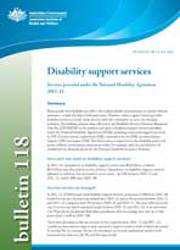Summary
Many people with disability are able to live independently and participate in society without assistance, or with the help of informal carers. However, others require formal specialist disability services to study, work, interact with the community or carry out everyday activities. This bulletin presents data collected in the Disability Services National Minimum Data Set (DS NMDS) on the number and types of disability support services provided under the National Disability Agreement (NDA), including community support (received by 43% of service users), employment (42%), community access (20%), accommodation support (13%) and respite (12%). This information is important as the disability policy and service delivery environment continues to evolve, for example, with the introduction of DisabilityCare Australia (formerly the National Disability Insurance Scheme).
How much was spent on disability support services?
In 2011-12, expenditure on disability support services was $6.9 billion, of which $6.4 billion was allocated for service delivery. Expenditure on disability support services, adjusted for inflation, has increased in recent years-by 10% between 2010-11 and 2011-12, and by 28% since 2007-08.
How has service use changed?
In 2011-12, 317,616 people used disability support services, an increase of 29% from 2007-08. Growth in the use of services has slowed since 2010-11, with a 1% increase between 2010-11 and 2011-12, compared with 7% between 2009-10 and 2010-11. This was reflected in the rate of service use which remained steady between 2010-11 and 2011-12, at an estimated 1 in 70 people in the general Australian population, after increasing each year up to that point (from 1 in 85 in 2007-08).
There were decreases in the use of some service types between 2010-11 and 2011-12, notably accommodation support and community support services, both of which decreased by around 3%. In contrast, the use of community access and employment services both increased over that time (by 5% and 4% respectively).
What are the support needs of service users?
The most commonly-reported disability groups continue to be intellectual (33%), physical (32%) and psychiatric (28%), though the proportion of service users with an intellectual disability has decreased over the 5 years to 2011-12.
Most service users needed some assistance in the activities of daily living (52%), independent living (61%) and in work, education and community living (57%).
The number of service users with an informal carer increased by 24% between 2007-08 (108,091) and 2011-12 (133,841), and by 5% between 2010-11 (127,777) and 2011-12.
In 2011-12, around 1 in 4 service users (26%) used more than one type of service.
1 What are disability support services?
1.1 Who provides disability support services?
1.2 How much was spent on disability support services?
2 How many people used disability support services?
3 Who used disability support services?
3.1 Age and sex
3.2 Aboriginal and Torres Strait Islander people
3.3 Country of birth
3.4 Living arrangement
3.5 Employment and income
3.6 Disability group
4 In what life areas was assistance needed?
5 What were the most common services used?
5.1 Users of multiple services
6 Informal care
6.1 How many service users had an informal carer?
6.2 Who provided informal care?
7 Profile of a service user by broad primary disability group
End matter: Acknowledgments; Abbreviations; Symbols; References; Related publications; Verso pages



